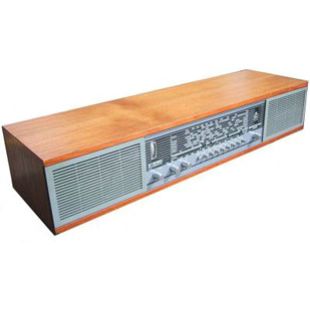Bang & Olufsen Designer Henning Moldenhawer

Henning Moldenhawer (1914-1983)
Amongst many other successful Bang & Olufsen creations, Henning Moldenhawer was responsible for the revolutionary Beomaster 900 - a long, low and fully transistorised mains radio, which played immediately – with no warm-up necessary, as was the case with the radio tubes – was an achievement in itself. In addition, the design concept challenged all established ideas for radio design. The new Beomaster 900 marked a revolution.
It was the architect Henning Moldenhawer who, for the first time in the history of radio, extended the front all the way out to the sides of the unit, breaking with the traditional framing of the front which all radios, TVs and loudspeakers had been using until then. This motif was retraced in Bang & Olufsen’s future design language. It was even repeated graphically in the company’s advertisements.
Beomaster 900 became a European-wide success. At the same time – and much to the company’s surprise – its share of the Danish market did not fall. On the contrary, it rose significantly – at a time when the last of the remaining Danish manufacturers went to the wall. Proof indeed that design is not only for connoisseurs, but is a universal language, at least when applied with talent and as an expression of the product’s conceptual content, i.e. making the product itself a communicator.
<b>Here, in addition, we also have a short Biography of Henning Moldenhawer, kindly submitted to BeoWorld by Mr Steen Rønn.</b>
<i>This was translated from Danish, so please forgive any grammatical errors!</i>
Henning Moldenhawer was born in 1914, the Son of a forest supervisor in the Frijsenborgwoods at Hammel near Aarhus in Jutland. As a boy he loved to explore the woods and to experiment with the wood he found; one of his favourite occupations was to build pushcars. As a grown up he also had a weakness for cars and motorbikes.
At 11 years old he was sent to boarding school in Sealand but hated the authoritarian form that marked schooling and leisure there. After one an a half years in grammar school it became too much for him : He was longing for the freedom of the woods and stopped attending the school – much against his parents’ will. He then passed an examination after 10th class at the local school in Hammel.
He went to Copenhagen, where he became an apprentice bricklayer, but he left the job before he got his apprenticeship and got a job as boy on a shipyard.
In 1936 he enrolled at the school of architecture in Copenhagen, but he never actually commenced study as his girlfriend discovered she was pregnant. They were married, and he was forced to find a job to make their living. Through a comrade he got a job at an architects office, but moved swiftly when a job at the drawing office of professor Palle Suenson (1904-87, architect, teacher at the architect school from 1934, headmaster of the Royal Academy of Art 1965-65) became vacant.
While working for Palle Suenson he later sent exercises for evaluation and became (on the basis of these) a member of the Academic Architect Society in 1949.
In 1948 he left his job at Palle Suenson’s drawing office as he and a colleaque, Mogens Hammer, wanted to establish their own drawing office. It was difficult to start a new business, and all the time they seeked eagerly for business. Moldenhawer got a contact to the radio- and televisioncompagny Linnet & Laursen (owned by outbreakers from Bang & Olufsen) and got designjobs here. Later followed work for another radio- and tv-factory, Neutrofon, where he created the Guldsegl-tv.
In 1962 B&Os Jens Bang got an eye on Moldenhawer and gave him the task to design the new transistorated mains receiver Beomaster 900. A few more radios followed and after that televisionsets with a so far never seen timeless design.
In 1966 the designer Jacob Jensen didn’t have work for a member of his staff, David Lewis, and Lewis got a job at Moldenhawer’s drawingoffice. Together they designed epochmaking tv-sets for B&O, parallel to Jacob Jensen’s famous radio-designing for B&O. In 1980 Lewis went solo and took the customer B&O with him.
I 1983 Moldenhawer got ill and died after a short sickbed, 69 years old.
Created: 6th February 2007
Modified: 12th July 2016


